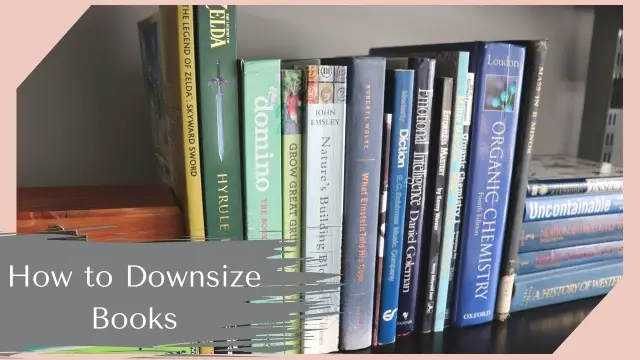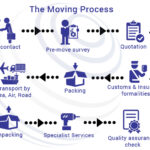What Should I Get Rid of Before Moving?
I. Introduction
Moving to a new home can be an exciting but also stressful experience. One way to streamline the moving process and make it more manageable is by decluttering before you move. Taking the time to review your belongings and eliminate unnecessary items can have numerous benefits. In this article, we will discuss why it’s essential to declutter before moving and the advantages of getting rid of items you no longer need.
Why it’s vital to declutter before moving
When you declutter before moving, you reduce the number of items you need to pack, transport, and unpack in your new home. Here are a few reasons why decluttering is essential before moving:
1. Cost-efficiency: Moving can be expensive, especially if you have a lot of belongings. By decluttering, you can save money on packing supplies, moving trucks, and storage units.
2. Time-saving: Decluttering before your move means you will have fewer items to pack and unpack, saving you significant time and energy during the moving process.
3. Less clutter in your new home: Moving to a new space is an opportunity for a fresh start. You can create a clean and clutter-free environment in your new home by eliminating unnecessary items.
4. Easier organization: With fewer items, organizing and finding what you need in your new home becomes more accessible. You can set up your new space more efficiently and better understand where everything is located.
Benefits of getting rid of unnecessary items
Getting rid of unnecessary items before moving can have various benefits, including:
1. Increased space: You create more space in your new home by decluttering. This extra space can be used for new furniture or decorations or to create an open, airy atmosphere.
2. Simplified packing: Packing can be a time-consuming and tedious task. By decluttering beforehand, you can simplify the packing process and focus on the items that truly matter to you.
3. Reduced stress: Moving to a new home can be a stressful experience, and having a lot of unnecessary items can add to that stress. By decluttering, you can create a more peaceful and organized environment, reducing stress during and after the move.
4. Donation or selling opportunities: When you declutter, you may come across items that are still in good condition but no longer serve a purpose for you. By donating or selling these items, you not only reduce clutter but also give them a new life and help someone in need.
Ultimately, decluttering before moving allows you to start fresh in a new home with a clean and organized space. It can save you time and money and reduce stress during moving. So, take the time to review your belongings and get rid of what you no longer need before embarking on your new adventure.
II. Clothing and Accessories
When preparing for a move, it’s essential to declutter and get rid of items that you no longer need or use. This includes clothing and accessories that may take up unnecessary space in your wardrobe. Here are some tips for evaluating and decluttering your clothes before the move:
How to assess and declutter your wardrobe
1. Assess your clothing: Take a close look at each item of clothing and ask yourself if you’ve worn it in the past year. If the answer is no, it’s likely time to let it go.
2. Consider your lifestyle: Consider your current lifestyle and if certain clothing items no longer fit your needs or style. For example, if you’ve transitioned to a more casual work environment, it may be time to part ways with formal business attire.
3. Only keep what fits: Be honest about clothing that works poorly. Keeping clothing that doesn’t fit can take up valuable space in your wardrobe and make it difficult to find items that do fit.
4. Get rid of duplicates: If you have multiple items that serve the same or similar purpose, consider keeping only your favorite and donating the rest.
5. Donate or sell: Once you’ve identified the clothing items you no longer want, consider donating them to a local charity or selling them online. This way, someone else can benefit from these items, and you can potentially make some extra money.
Tips for organizing and packing clothing efficiently
1. Categorize your clothing: Organize your clothing into categories such as tops, bottoms, dresses, and outerwear. This will make it easier to pack and unpack when you arrive at your new home.
2. Use vacuum-sealed bags or packing cubes: Vacuum-sealed bags can help compress your clothing and save space in your moving boxes. Packing cubes are also great for compartmentalizing and keeping your clothes organized during the move.
3. Label your boxes: Clearly label each box with the contents and designated room in your new home. This will make unpacking much more accessible and help you locate specific items when needed.
4. Protect delicate items: If you have fragile or sentimental clothing items, consider wrapping them in tissue paper or cloth to prevent damage during transit.
5. Pack seasonal clothing separately: If you’re moving during a specific season, pack clothing for that season separately. This will allow you to access the clothes you need immediately without having to unpack everything immediately.
By decluttering and organizing your clothing before the move, you’ll save space, reduce clutter, and make the unpacking process much smoother when you arrive at your new home.
III. Furniture and Appliances
Determining which furniture and appliances to keep or discard
Moving to a new home is the perfect opportunity to reassess your furniture and appliances and decide what is worth keeping and what you should get rid of. Here are some factors to consider when determining which items to keep or discard:
1. Condition: Take a close look at the condition of your furniture and appliances. It may be time to let go of worn out, damaged, or no longer functioning correctly.
2. Size and Space: Consider the size and layout of your new home. Some furniture pieces or large appliances may not fit or be suitable for the new space.
3. Style and Preference: Your taste in furniture and appliances may have changed over time. If certain items no longer fit your style or aesthetic, it might be best to part ways with them.
4. Emotional Attachments: Some furniture pieces or appliances may hold sentimental value. In such cases, it’s essential to consider whether they are worth keeping for their sentimental value.
Methods for selling, donating, or disposing of unwanted items
Once you have decided which furniture and appliances to get rid of, there are several options for selling, donating, or disposing of them responsibly:
1. Selling: If your furniture or appliances are still in good condition, you can consider selling them to recoup some costs. Online marketplaces, local classifieds, and yard sales are popular ways to sell unwanted items.
2. Donating: If your furniture or appliances are still usable but no longer need them, consider donating them to local charities, shelters, or thrift stores. This way, someone in need can benefit from them.
3. Recycling: Some items, such as old electronics or appliances, may contain hazardous materials and must be disposed of properly. Check with your local recycling centers to see if they accept these items for recycling.
4. Junk Removal Services: You can hire a junk removal service to properly dispose of items that are no longer usable or too difficult to sell or donate. These services will ensure that the items are disposed of in an environmentally responsible manner.
You are planning and decluttering well before your moving date is essential. This will give you ample time to sell, donate, or dispose of unwanted furniture and appliances in the most responsible way possible. Remember, a fresh start in your new home can also mean a fresh start with your belongings.
IV. Paperwork and Documents
Sorting and organizing necessary paperwork
When moving, you must sort through your paperwork and documents to determine what you need to keep and what you can eliminate. Here are some tips for sorting and organizing your essential paperwork before the move:
- Create categories: Start by creating categories for your paperwork, such as financial documents, legal documents, health records, and personal records. This will help you stay organized throughout the process.
- Go through each category: Take the time to go through each category and weed out any unnecessary paperwork. Ask yourself if you need to keep each document and consider whether it’s easily replaceable or available digitally.
- Keep important documents: Hold onto essential documents like birth certificates, passports, social security cards, and marriage certificates. These are typically required for various legal and administrative processes.
- Consider scanning and digitizing: If you have a lot of paperwork but don’t want to keep physical copies, consider scanning and digitizing essential documents. This will help reduce clutter and make it easier to access and organize your files digitally.
- Organize your files: Once you’ve sorted through your paperwork, organizing your files in a way that makes sense is essential. Use folders, labels, and a filing system that best suits your needs.
Proper disposal of sensitive documents
When getting rid of paperwork and documents, it’s crucial to dispose of sensitive information properly to protect your identity and sensitive data. Here are a few options for disposing of sensitive documents:
- Shredding: Invest in a good-quality shredder and use it to shred any paperwork that contains personal information, such as bank statements, credit card statements, and medical records. Shredding ensures that the data cannot be retrieved or used maliciously.
- Secure disposal services: If you have a large volume of sensitive documents, consider using a fast disposal service. These services use industrial-grade shredders and ensure that your documents are destroyed.
- Burning: If you prefer a more low-tech approach, you can burn sensitive documents in a controlled and safe manner. Make sure to follow local regulations and guidelines for burning documents.
- Digital options: You can securely delete digital copies if you’ve scanned and digitized your essential documents. Use secure deletion methods and ensure that the files cannot be restored.
Remember, when getting rid of paperwork, be mindful of any legal obligations to retain certain documents for a specific period. Consult with legal professionals or relevant authorities if you are unsure which records to keep or how to dispose of properly.

V. Books, CDs, and DVDs
When preparing for a move, it’s essential to consider downsizing your book and media collections. Carrying excessive books, CDs, and DVDs can add unnecessary weight and take up valuable space in your new home. Here are some tips on how to effectively downsize your collections:
How to reduce your book and media collections
1. Assess your collection: Look at your books, CDs, and DVDs and ask yourself if you need to keep them all. Consider if you’ve read or watched them recently and if they hold sentimental value or are easily replaceable.
2. Set aside favorites: Select a small number of books, CDs, and DVDs you love and want to keep. These can be items that have significant sentimental value or ones that you frequently revisit.
3. Consider digital options: If you have an extensive collection of CDs and DVDs, consider converting them to digital formats. This will allow you to keep your favorite movies and music while reducing physical clutter.
4. Donate or sell: If you have items that you no longer need or want, consider donating them to local libraries, schools, or charities. Alternatively, you could sell them online or at second-hand stores to make extra money.
5. Recycle responsibly: If your books, CDs, or DVDs are damaged beyond repair or are not in demand, make sure to recycle them in an environmentally friendly manner. Check with your local recycling facilities to see how you can properly dispose of these items.
Options for selling, donating, or recycling these items
1. Online marketplaces: Websites like eBay, Amazon, or Craigslist allow you to sell your books, CDs, and DVDs directly to interested buyers. Make sure to accurately describe the condition of the items and set a competitive price.
2. Second-hand stores: Many local second-hand stores accept used books, CDs, and DVDs. They may offer you store credit or cash in exchange for your items.
3. Libraries and schools: Reach out to your local libraries or schools to see if they accept donations. These institutions are often in need of new materials for their collections.
4. Charities: Consider donating your books, CDs, and DVDs to charities that accept these items. You will declutter your space and contribute to a good cause.
5. Recycling facilities: If your items are damaged or cannot be reused, recycle them responsibly. Check with your local recycling facilities for the proper disposal methods.
Remember, downsizing your book and media collections before a move can help simplify the process and lighten your load. It’s an opportunity to declutter and create a fresh start in your new home.
XI. Conclusion
The importance of starting early and staying organized during the decluttering process
As you prepare for a move, it is essential to declutter your current space to make the transition more accessible and more efficient. Starting early and staying organized throughout the decluttering process can save time and energy when packing and unpacking in your new home. Here are some key takeaways to remember:
1. Plan: Give yourself time to review your belongings and decide what to keep, donate, or discard. Starting early will alleviate stress and allow you to make thoughtful decisions.
2. Stay organized: Create a system for categorizing items, such as using boxes or bins labeled “keep,” “donate,” and “discard.” This will help you stay focused and ensure that everything is sorted correctly.
3. Be selective: Consider each item’s practicality and sentimental value. If you haven’t used or worn something in a year, it may be time to let it go. Remember, moving is an opportunity for a fresh start.
4. Donate or sell: Instead of throwing away items in good condition, consider donating them to a local charity or selling them online. This way, someone else can benefit from your unwanted items.
5. Dispose of hazardous materials: Check with your local waste management facility for guidelines on properly disposing of hazardous materials, such as cleaning chemicals or old paint cans.
Tips for maintaining a clutter-free home in the future
Once you have successfully decluttered before your move, you must develop habits that will help you keep a clutter-free home in the future. Here are some tips to consider:
1. Regular decluttering: Make decluttering a habit by setting aside time once or twice a year to go through your belongings and remove anything you no longer need or use.
2. One in, one out: Adopt the “one in, one out” rule. Donate or discard one item for every new item you bring into your home. This will help prevent clutter from accumulating again.
3. Stay organized: Invest in storage solutions such as bins, shelves, or baskets to organize your belongings. Establish designated spaces for different items so that everything has a place.
4. Think before buying: Before making a purchase, ask yourself if you truly need the item and if it will add value to your life. Avoid impulse buying and be mindful of what you bring into your home.
5. Mindful consumption: Embrace a more minimalist lifestyle by practicing mindful consumption. Focus on experiences and meaningful connections rather than material possessions.
Following these tips and maintaining a clutter-free mindset can create a more organized and peaceful living environment in your new home. Happy decluttering and happy moving!






